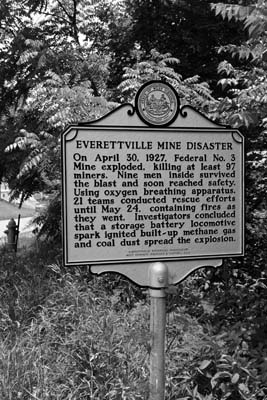Gone, Not Forgotten
Recalling the Everettville Mining Disaster
By Shannon Colaianni Tinnell

West Virginia State Historical Highway Marker near the site of the 1927 Everettville mine disaster in Monongalia County. Photograph by Tyler Evert.
April 30, 1927, proved a memorable date in West Virginia history. In Summers County the Federal Industrial Institution for Women, the first women’s federal prison in the United States, opened its doors for women serving prison sentences of a year or more. That same day, over 175 miles away, miners found themselves in a prison of a different sort, as a result of a deadly mine explosion. Unlike those at the progressive new prison created to provide a future for the women sentenced to Alderson, 97 men at the Federal No. 3 mine in Everettville, Monongalia County, received a death sentence that spring day. Nearly forgotten, their story has recently been told, and a new memorial marks the place where they had fallen.
Monongalia County, like most of the Mountain State, is part of the Appalachian coal region, which produces more than one third of the coal in the United States. West Virginia’s coal mining history dates back to the late 18th century, when the area was still a part of Virginia. Residents at the time were known to dig up small outcrops of coal to heat their homes. It would take the Industrial Revolution to thrust coal into its eventual role as a valuable fossil fuel and a dominant economic and cultural force in the region.
Two major changes occurred in Monongalia County that opened the area to outside markets and encouraged growth: the coming of the B&O railroad to Morgantown in 1886 and, in 1890, the completion of a series of locks and dams on the Monongahela River, which improved water commerce to the Pittsburgh market and beyond. With two reliable modes of transport and fueled by the subsequent growth of area coal-mining operations, the region was poised to take its place among the beneficiaries of the Industrial Revolution.
One problem remained: the area’s population was not large enough to staff the necessary workforce needed to meet the demand for labor. Area industries turned to the solution other regions embraced, namely recruiting immigrants from Southern and Eastern Europe, and African Americans from other states, to work the mines, plants, and factories.
You can read the rest of this article in this issue of Goldenseal, available in bookstores, libraries or direct from Goldenseal.